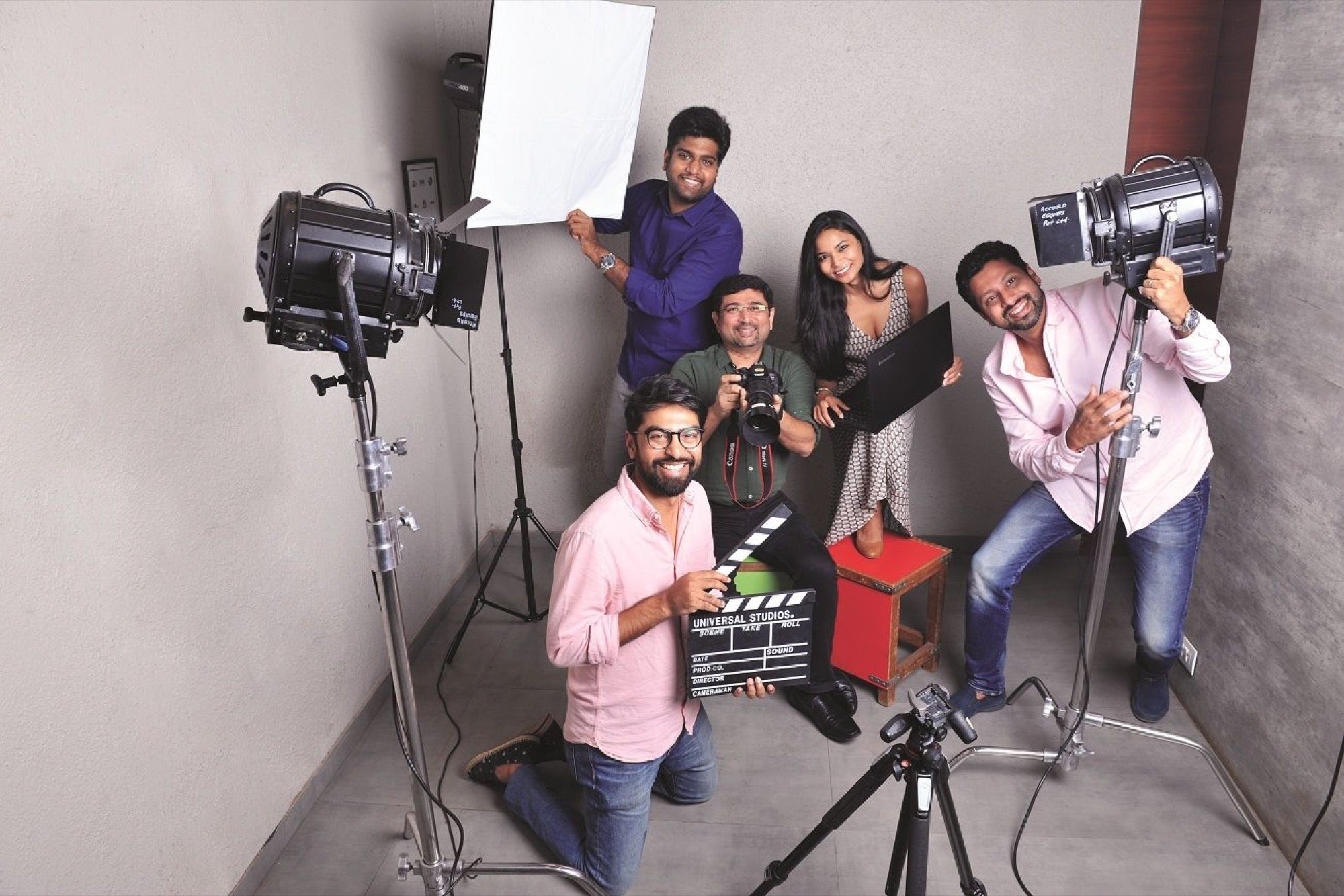These Digital Entertainment Junkies are Out to Conquer the World What begins now is the democratization of digital entertainment content, led by start-ups, that's snackable, light, personalized, unrestricted and relateable to the millennials
By Sandeep Soni
Opinions expressed by Entrepreneur contributors are their own.
You're reading Entrepreneur India, an international franchise of Entrepreneur Media.

Entertainment is the fourth sine qua non added to the popular slogan of our socialism – food, clothing and shelter (Roti, Kapda aur Makaan). While smartphone actually outsmarted the "idiot' box in recent past as the primary screen for entertainment, the 4G roll-out reinforced digital to be the new mass entertainer.
What begins now is the democratization of digital entertainment content, led by start-ups, that's snackable, light, personalized, unrestricted and relatable to the millennials. Oh! And of course anti-saas bahu, allergic to melodrama, and over-the-top get ups.
The widening gap between TV and smartphone for content consumption is more overwhelming than ever. The global voice on Internet and new technologies, Mary Meeker, in her annual Internet trends report this year, announced that Indians remain hooked to their phones for 28 hours in a week against petty four hour duration on TV. But what's at least less than obvious though not highly unexpected, is that 45 per cent of those 28 hours, that is around 12.5 hours are spent on watching entertainment content that primarily includes Internet first or Internet only channels, video streaming services including All India Bakchod, Hotstar, The Viral Fever (TVF), Voot etc. 34 per cent time is spent on search, social and messaging which otherwise was the de facto areas of online consumption until data costs crashed down.
"Before 4G roll out, the mobile Internet consumption was fundamentally around social media and shopping. While the demand for video content was there but because of higher data cost it was fairly restricted. But with 4G along with Jio's entry in the market, the cost came down dramatically even as the speed increased which led to boost in video consumption," says Girish Menon, Partner, Deal Advisory, KPMG India.
Internet Originals
This has led to change in India's socio-economic profile where people from low-income group can access content digitally along with demographic deepening - beyond 35 years of age, and penetration beyond tier II and tier III cities. In fact for many of them, affordable smartphone is the only source of Internet. They might not use it for shopping but video consumption will continue to be a fairly significant component of Internet usage.
Nonetheless there is a difference between putting TV shows online and generating original shows for digital specifically. The latter is where the maximum opportunity for emerging online channels or start-ups across categories is. This includes short films, spoofs or parodies etc., in short and long format videos ranging from around four minutes to up to 90 minutes on different over-the-top (OTT) players such as YouTube (biggest platform), Facebook, WhatsApp, Instagram etc.
This opportunity exploded when such start-ups or online entertainment channels realized that millennials particularly are not able to connect to the content on TV. Hence, unlike TV, the audience cannot be generalized on digital and that calls for niche or original content.
"On TV everything looks unreal right from actors, location, make up, dresses, issues they deal with in daily life etc. With TV penetrated into villages, the content quality is more regressive whereas on digital it is progressive in terms of uniqueness and it connects with youth," says Mohit Hussein, Co-Founder, Shitty Ideas Trending (SIT) – a comedy channel on YouTube that created its first web series on couples' relationship.
Hussein has been the director for last 18 years and has directed TV shows including Veera, Bade Achhe Lagte Hain etc., and is married to actress Chhavi Mittal, last seen in daily soap Krishnadasi that aired on Colors channel last year. "We are looking at reaching around seven lac subscribers on YouTube and at least 15 lac followers on Facebook by end of this year," says Mittal. The company has more than 120 videos on its channel. Every Friday a new video is released but, "that's a challenge to bring out a fresh piece of content every Friday that your community likes," asserts Hussein.
Along with such entertainment channels exist video-ondemand platforms like Netflix, Amazon Prime, Hotstar, and Voot apart from user generated content. While every category creates videos on unique subjects, but the chances of a bit of an overlap is certain. And as more players come in, there would be need to create more engaging content that is distributed faster even as none of them have to vie for audience attention but to make sure subscribers don't leave the channel or paid network.
"A lot of that depends on the distribution platform. TVF gets more traction on YouTube than their own platform because of YouTube's depth of users. Above 50 per cent of online viewership happens on YouTube which like a supermarket has everything for any kind of audience," says Menon.

However, it is difficult to predict what form of video streaming would have an upper hand. "Social networks will have a big advantage which would be difficult to beat because they have a community and it reaches multiple people very quickly with great virality. They will challenge big TV networks like Netflix," says Ashwin Suresh who launched Pocket Aces along with Anirudh Pandita. Sequoia Capital backed digital entertainment company has multiple content brands including FilterCopy, short form content; Dice Media, long form storytelling of around 17-18 minutes and Gobble which is into food content. "We are currently getting around 75 million views a month across three channels," says Aditi Shrivastava, another co-founder at Pocket Aces.
Reaching Regional
Largely, the content distribution for these start-ups happens on YouTube and Facebook followed by WhatsApp, Instagram and lastly Snapchat. However, the spread of content on YouTube is done through WhatsApp, or Facebook. The approach though for YouTube and Facebook is different.
"Users have different mindsets on the two platforms. On YouTube, it is only about watching videos while Facebook is more personal," says Anand Doshi, Co-Founder, Click Digital Studios. The four-year-old start-up runs 80 channels including animation, live shows, voice over and image based, and produces around 200 videos across its channels including its animated bollywood spoofs under the channel Shudh Desi Endings with combined monthly traffic of 350-380 million views. "YouTube has been the medium for us largely so far but Facebook is catching up," adds Doshi. As per an Ernst & Young report in 2016 on future of digital content consumption in India, the audience is increasingly looking for regional content with 93 per cent of the time spent on videos in different languages including Hindi. In fact nine out of 10 new users on Internet for the first time are language users but the challenge explains Menon, is that "there is not enough structured regional content available."
Short films distributor and maker Pocket Films however does focus on regional content. "We have content in different languages including Marathi, Bengali, Tamil, Malayalam etc," says Saameer Mody, Founder and Managing Director, Pocket Films. The company across its network gets around 60 million monthly views. Mody releases a short film every day and has a library of over 5,000 videos.
The revenue sources are generally ads and brand engagement in the videos apart from content syndication for other platforms including TV. Shudh Desi Endings also earns via spoofs for new movie releases. "Movie producers have realized that to cater to the millennials, releasing trailers just on TV will not reach to the entire audience, so they want to cater to them through us," adds Doshi. On the other hand SIT has done branded videos for Flipkart and some restaurants in Mumbai while Pocket Films airs content from its catalogue on NDTV Prime every week and to certain OTT players like Hungama Play that adds to their respective revenues.
The challenge however is in getting ads on content. "The rate of growth of monetization vis a vis rate of growth of viewership is not in sync. So the challenge is in getting more ads on content. When the viewership reaches around more than a million then there is something substantial that comes your way," explains Mody. Since it is highly ad dependent and digital evolution is at very early stage in India, the economics doesn't back up for these start-ups. The money needed to create content versus the revenues they earn suffers a mismatch. "While the gap will reduce over time but unless subscription model evolves, it will be difficult for investment to happen consistently on original content," concludes Menon.













